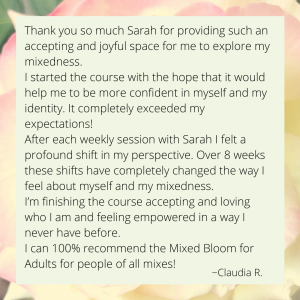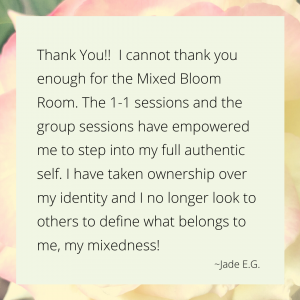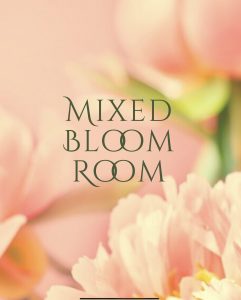Interrogating Mixedness: The Mixed Bloom Room
Written by Nina Camara
Conversations about race in multiracial families can be challenging. Unlike individuals from Black monoracial background who still have ‘the talk’ with their parents, for many mixed-race people the topic of race is a taboo. In addition, though race is a social construct, silence can also create barriers. Sarah Lotus Garrett, a coach working with mixed-race individuals and families, talks about the importance of addressing the topic of race in a way which is constructive, and contributes towards mutual understanding.
You were born into a mixed race family. Can you tell us a bit about your background and when you became aware of the influence race had on your life experience?
Well I was born in 1969 in San Francisco, so right after the Loving decision in 1967. My mom is white American but with a British background from generations back. My dad was Black and grew up in Chicago and his family was from Arkansas and before that Virginia and before that West Africa. I think that I was around seven when I became more aware of how people felt about the colour of my skin. I used to go to this thrift store across the street from my house because I’ve always loved old stuff, and the store owner, a white woman, used to come stand right next to me and, you know, start ‘organizing’ and ‘cleaning’. She was always watching me. I was a little girl, I did not know what stealing was, but I could see that she didn’t trust me and, you know, I had a hunch as to why. I think that as little kids we know what racism looks like but we don’t have any language for it… but we know that it goes back to the colour of our skin. I think this is especially problematic for mixed people who are raised within a whiteness that refuses to talk about race because they may never learn to ‘language’ their own experiences with racism.
As you were growing up, what was the conversation about race like in your own family? Is it different in how you address it now from a position of a parent?
We did not overtly talk about race growing up. My mom talked about how much she loved black music and she sort of believed that black people were just cooler than everyone else. However, we did not talk about race in terms of the systems or the things that I was going through. There was no space dedicated to talking about race in the way that I really needed to be talking about it, you know… no space around black pride and there was no protective space; what racism looks like and how to protect myself…. so, no, we did not talk about race while I was growing up, which is just so harmful. Now I talk about race with my kids often. It is a normal part of our conversations so if it comes up, it comes up and of course it does because we’re dealing with it all the time. In a mixed family it comes up in different ways… I do a lot of, I would say, work with my husband because he’s white, so we talk about it in that context. The kids talk about it in the context of them and what they’re going through as mixed people and also colourism, which is something that we also talk about. We talk about how it shows up when we see it in the media and stuff. We also talk about the patriarchy and capitalism. I think it’s really important for children to have the choice of whether or not they’re going to participate in the systems of oppression. In order for them to be able to make that choice they need to know about the systems of oppression that they’re dealing with. I think that children, because they are so invested in fairness, will choose fairness and the systems aren’t fair and it’s a pretty easy choice when you put it in that perspective.
As a coach, have you noticed any attitudes or behaviours that hinder this conversation?
Absolutely. I think that talking about race is especially difficult for white people and I see a lot of parents who are worried that they’re going to get it wrong, that they’re going to talk about race incorrectly or make mistakes and make it worse or that they may say something that reveals their own racism and so they just don’t talk about it at all. I think that ‘I don’t see colour’ is sort of a smoke and mirrors way of not talking about race because they really just don’t wanna talk about it.
What do you think of a colourblind approach to raising mixed-race children?
I think one of the reasons that the ‘colourblind’ approach to raising mixed race children causes harm is because it does not acknowledge the realities of living in a mixed body and mind and it allows no space for processing the very real ramifications of living in a racialized world. It’s also a form of gaslighting used to avoid deep inner exploration about one’s own relationship with white supremacy. In addition, the ‘colourblind’ approach doesn’t allow for the space to acknowledge and celebrate our differences and so there’s little room for multiracial expression and pride which is one of the most important aspects to consider about raising mixed children.
When trying to discuss their experiences, individuals in mixed race families sometimes face resistance from their monoracial family members. Why does this happen and what could they do to overcome it?
I think this is a really interesting question because it puts the responsibility of this situation on the mixed person and they are not responsible for someone else’s resistance to talk and listen to others. I think that it is important for mixed people to have their own mixed community, a place where they can be seen in their mixedness… a community of people who can help to affirm the issues being confronted and help establish where boundaries could be set. I think it’s imperative that mixed people understand how important boundaries are with their family members in regards to what they will and will not discuss or explore with them as well as a clear understanding of the limitations of others. I think a lot of mixed people feel obliged to just allow anything because it’s a family member but I disagree with that… I think it’s perfectly fine to have boundaries about what you will and will not discuss and follow through with those boundaries, believe in those boundaries… take care of yourself.
In your experience, what typically motivates people to seek coaching with regards to mixedness?
The mixed adults who take the course do so because they have a deep desire to feel whole and also, I think, to finally centre mixedness in their lives, if even for only a bit! In the beginning of the course we always do an explorative activity, sort of like, what is motivating you to take the course and most people want to feel whole in their mixedness and they’re missing this because as mixed people we are expected to divide ourselves into parts and we are not parts… so there is a deep desire to feel whole and integrated, to feel wholly integrated, also just to feel true self-love and have more confidence, to know themselves and their mixedness more intimately. For the monoracial parents of mixed children it’s to parent with more confidence, to understand mixedness more, to be prepared for issues that will arise with their children and to examine their own racial biases that they have, as well as start or continue their commitment to anti-racism work.
Can you tell us about your approach to helping your clients open up about their experience and build confidence?
The Mixed Bloom Room coaching course that I offer is really about centering mixedness in a space that is deeply explorative, nonjudgmental, compassionate and joyful. It is a space to center mixedness with compassion, a place to explore limiting beliefs that hold us back and learn new tools and ways of thinking that empower people to seek out and create the life that they want. It’s a space where parents can come to gain the confidence they seek in parenting their mixed children and shed some biases and narratives that have been holding them and others back. One of my main goals with the Mixed Bloom Room is to help mixed people get sorted with their own mixed identity so that they can go out in the world and thrive, you know, live the life they truly desire. I’m very enthusiastic about the Mixed Bloom Room space that I’ve created and so my clients are too.








